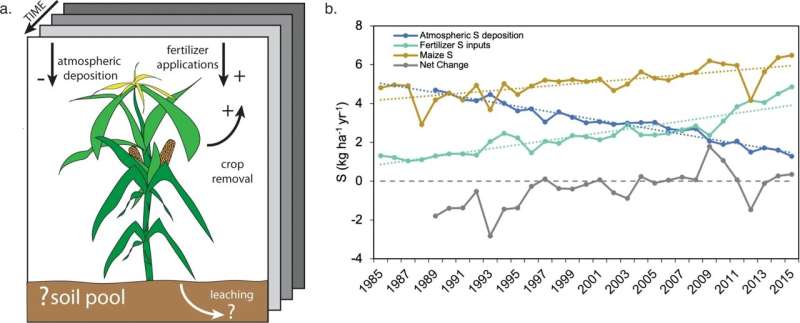This article has been reviewed according to Science X's editorial process and policies. Editors have highlighted the following attributes while ensuring the content's credibility:
fact-checked
peer-reviewed publication
trusted source
proofread
Air quality improvements lead to more sulfur fertilizer use, shows study

Sulfur, an essential nutrient for plants, was as free as air back in the 1980s, drifting down onto farmers' fields from the polluted sky. The nutrient also caused acid rain, however, and it triggered chemistry that meant more mercury in fish. Regulations led to less sulfur in the air, but in the Midwest, where sulfur-hungry corn and soybean fields were proliferating, crops still needed the nutrient.
"We find a clear increase in sulfur fertilizer use commensurate with a decline in atmospheric deposition," said Eve-Lyn Hinckley, a Cooperative Institute for Research in Environmental Sciences (CIRES) fellow, University of Colorado Boulder ecologist and lead author of a new assessment of sulfur fertilizer use. "We have compiled the first time-series of sulfur fertilizer data spanning decades, from 1985-2015."
As sulfur stopped dropping from the sky, farmers began applying it directly, Hinckley and her colleague, Charles Driscoll from Syracuse University, reported in late December in the journal Communications Earth & Environment. Moreover, sulfur fertilization accelerated quickly, they found, far outpacing the growth in use of other nutrients such as nitrogen and phosphorus.
That's significant, because sulfur's impacts can be serious: the chemical can essentially make heavy metals, including toxic mercury, more "mobile" and more likely to make their way into fish, for example.
Hinckley said it's not yet clear how extensively sulfur fertilization impacts the mercury cycle.
"It's the same form of sulfur as was going on with acid rain. However, that was diffuse, widespread atmospheric deposition, and this is intense, targeted applications in much larger amounts." She and her colleagues are already digging into the connection, "looking at the potential interaction between agricultural sulfur runoff and stimulation of methylmercury formation downstream."
Even with the environmental risks, farmers do need sulfur fertilizers, Hinckley said, and her work does not suggest prohibiting them. In the case of other nutrients that can cause environmental harm when applied in excess of crop requirements—such as nitrogen and phosphorus—agricultural experts have learned how to minimize damage with selective timing and amounts of application. That's the goal of her work with sulfur, she said. "We want to help people use it smartly and understand what it does in the environment."
More information: Eve-Lyn S. Hinckley et al, Sulfur fertiliser use in the Midwestern US increases as atmospheric sulfur deposition declines with improved air quality, Communications Earth & Environment (2022). DOI: 10.1038/s43247-022-00662-9
Journal information: Communications Earth & Environment
Provided by University of Colorado at Boulder

















